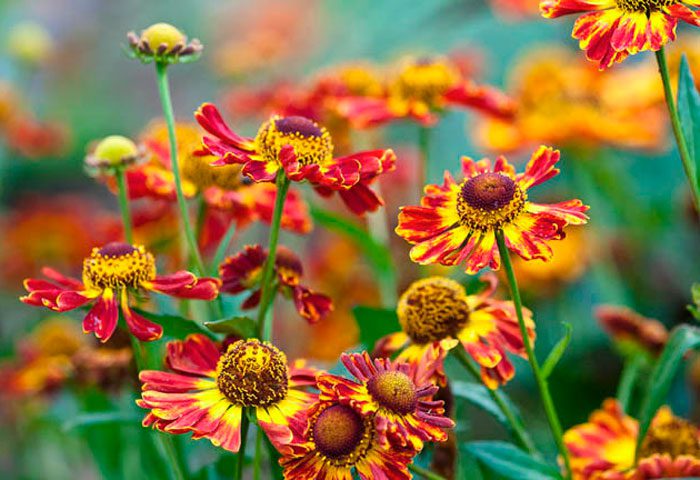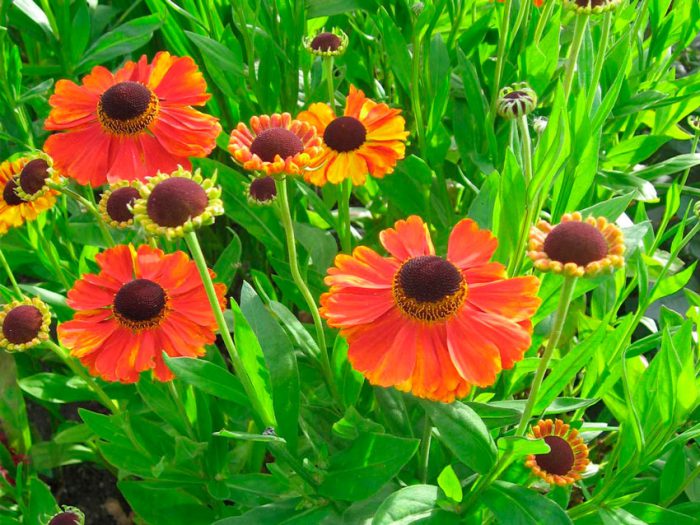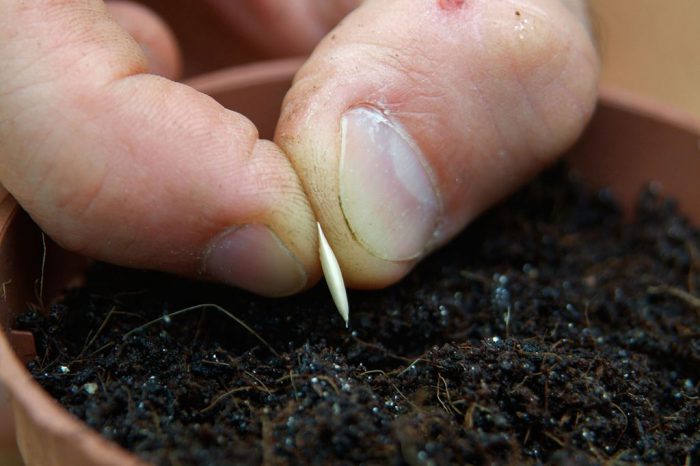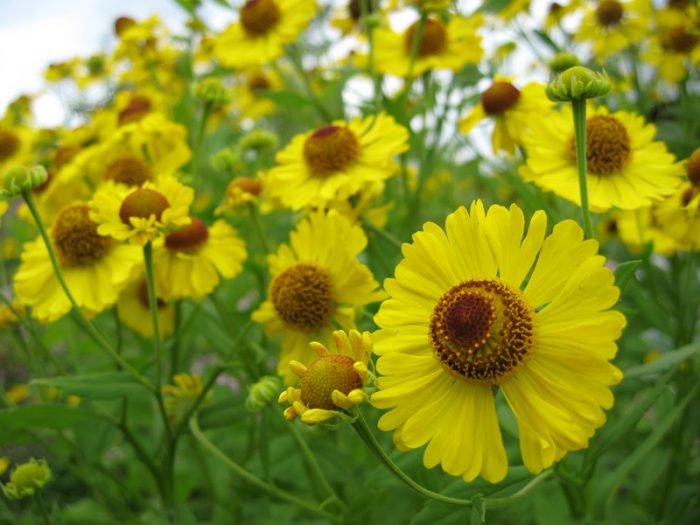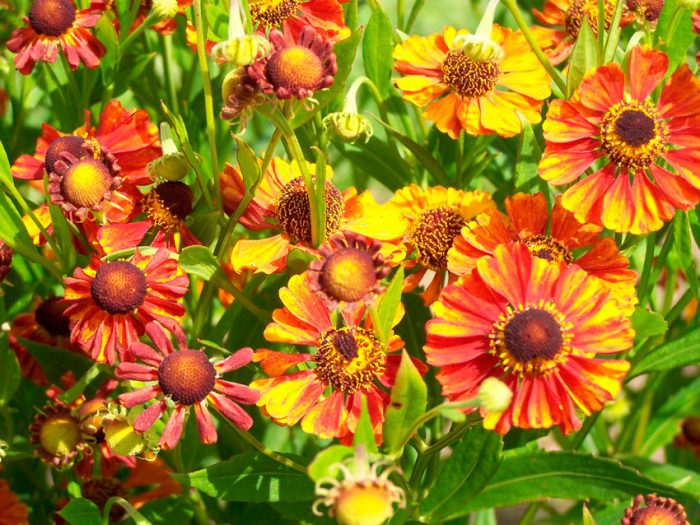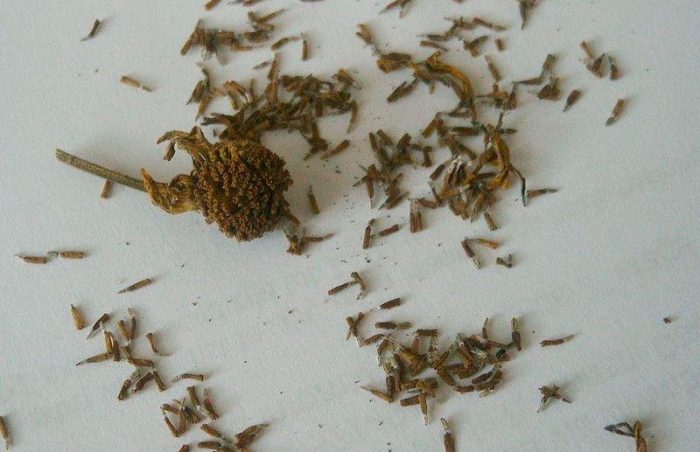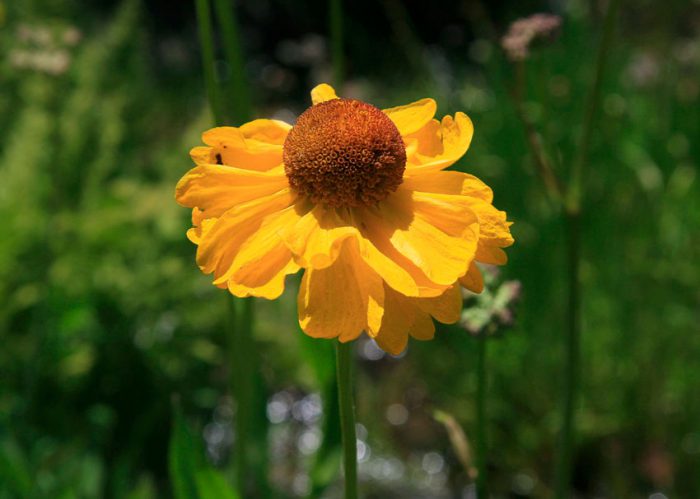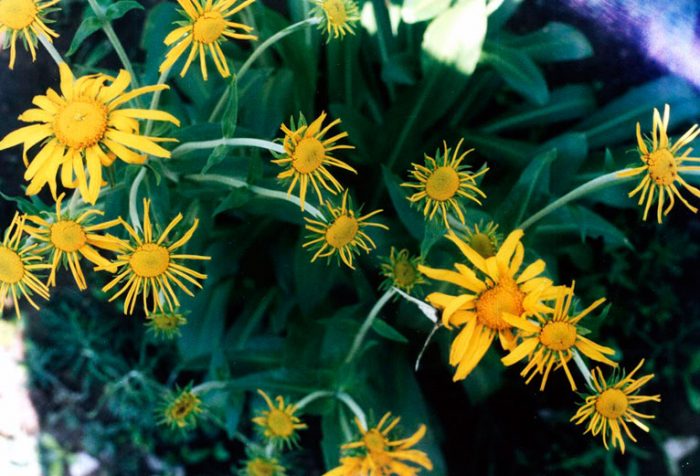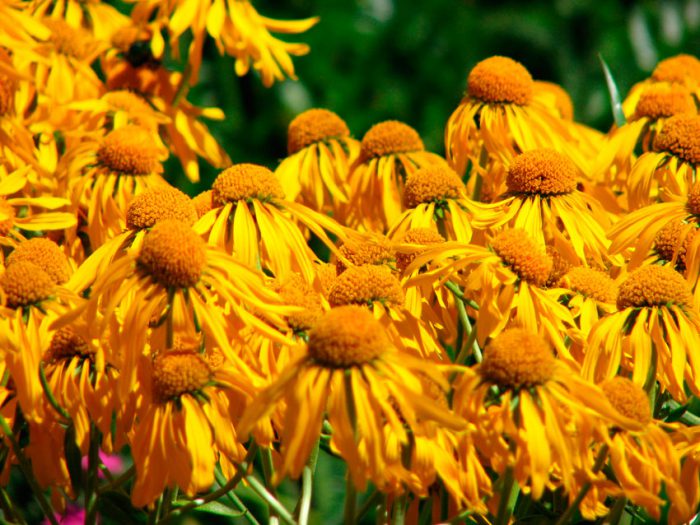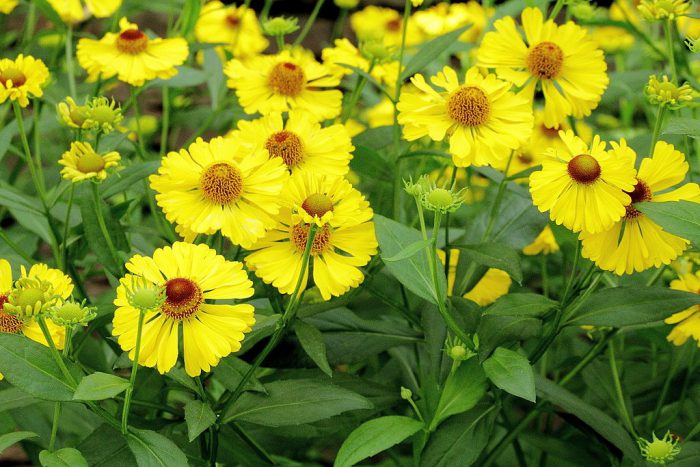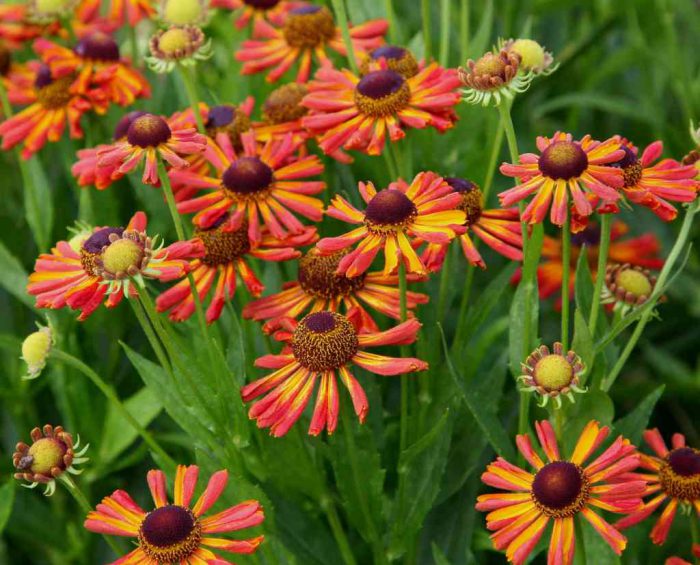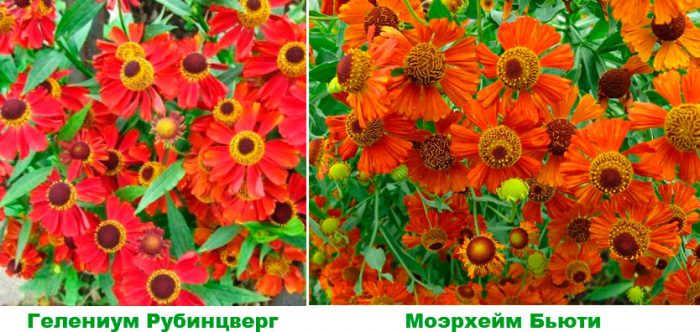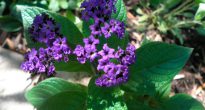Gelenium (Helenium) is an annual or perennial plant of the Asteraceae family. This genus unites about 32 species. Naturally, they can be found in North and Central America, and most of them grow in the western United States. It is believed that this plant was named helenium in honor of the wife of King Menelaus, the charming Helen, who became the reason for the outbreak of the war between Troy and Greece. She was described in the Iliad by Homer. What makes such plants stand out. The fact is that until a certain time they differ in a completely unremarkable appearance. At the end of the summer period, when many plants are already withering away, helenium appears in all its glory. Its inflorescences-baskets of golden color, which can change their color, look very elegant and fill the garden with their "calm" beauty ...
Content
Gelenium features
This perennial plant has a very interesting feature. In autumn, its root system dies off, as does the peduncles. However, the one-year-old shoot has underground buds, from which roots and a new rosette consisting of leaves grow in autumn. Young flower stalks will appear from this outlet next year. The helenium bush familiar to everyone is independent plants growing close to each other. They have straight shoots that branch in the upper part, while they can reach a height of 150 centimeters. Alternate leaf plates have a lanceolate shape. Inflorescences-baskets can be single or be part of corymbose inflorescences. The structure of the baskets includes marginal reed flowers, which can be brown, red, purple, orange or yellow, as well as from the central tubular - painted in brown or yellow. The fruit is a pubescent, oblong-cylindrical achene.
Growing helenium from seeds
The seeds of such a plant have a low percentage of germination and it does not matter if they are freshly harvested or not. Of course, if you have a great desire, you can try to grow such flowers from seeds, but it's still easier to propagate them with leaf rosettes and dividing the bush.
Sowing seeds in autumn can be done directly in open ground. They can also be sown for seedlings in February or March, but it should be borne in mind that such crops will need stratification. So, the seeds are spread over the surface of the substrate, after which the container is placed in a polyethylene bag. After that, this container is removed to the refrigerator shelf for 4–6 weeks. After that, the container with seeds is removed and placed in heat under artificial lighting. The optimum temperature for the emergence of seedlings is from 18 to 22 degrees. After the plants have 2 or 3 true leaves, they should be picked.
Landing in open ground
What time to plant
It is necessary to plant seedlings in open ground only when the night frosts are left behind. As a rule, this time falls on May or early June. For planting, it is best to choose a well-lit area, but you can also grow helenium in a shaded place. A light soil is best, but must be nutrient-dense, well-drained and neutral. Before planting seedlings, it is recommended to dig up the soil with compost to the depth of a shovel bayonet.
How to plant
It should be noted that the size of the planting hole should be a couple of times the size of the root system. Before placing the plant in the hole, its roots must be kept in a container with clean water for several minutes. Seedlings must be planted at the same depth at which they were grown in containers. It should be remembered that at least 30 centimeters must be left between the specimens, and the row spacing must be 35 centimeters. When the flowers are planted, the soil surface should be sprinkled with a layer of mulch (humus or peat). A plant that was grown from seed through seedlings will begin to bloom only in the second year after planting. It should also be remembered that only species are recommended to grow from seeds. Varietal species need to be propagated using vegetative methods, the fact is that flowers grown from seeds are not able to maintain the varietal characteristics of the parent plant.
Care features
It is very easy to grow and care for such a plant, but you should study all the basic rules. It should be remembered that watering is very important for such a plant, since it reacts extremely negatively to a lack of moisture. After a long dry, sultry period begins in the summer, watering helenium should be done more often and more abundantly. However, it must be remembered that stagnation of water in the soil should not be allowed, in this regard, the land must necessarily have good water permeability. The soil should be periodically loosened shallowly, and all weeds should be removed in a timely manner. However, if you use mulching, then caring for such a plant will be much easier. During the summer, this flower must be fed 3 times, while using organic and mineral fertilizers:
- In May. For feeding, prepare a solution that contains 10 liters of water and 1 large spoonful of potassium sulfate, urea and Effekton organic fertilizer. 1 m2 used from 3 to 4 liters of this mixture.
- During flowering. For a bucket of water, take 1 liter of liquid mullein, as well as one large spoonful of Agricola-Fantasy and Agricola-7. Moreover, for 1 m2 taken from 2 to 3 liters of solution.
- In the last days of October. In a bucket of water, you need to dissolve 1 large spoonful of potassium sulfate and superphosphate. Moreover, for 1 m2 half a bucket of the mixture is taken.
At the beginning of the budding period, you need to spray the plants with a solution that will help normalize the process of bud formation. To prepare the mixture, take 1 bucket of water and 10 g of Bud.
For more abundant flowering, you need to cut off those inflorescences that have begun to fade in time. At the same time, you can make the bush more dense and branched by pinching the tops of the stems.Also, overgrown perennial plants need to be planted 1 time in 2 or 3 years. During transplantation, helenium multiplies by dividing the bush. Planting the plant is best in springtime.
Diseases and pests
Such flowers are distinguished by their resistance to diseases and harmful insects. Very rarely, chrysanthemum nematodes can settle on the helenium, which harm flower buds and leaf plates. As a result, they turn brown and begin to dry out. Those parts of the plant that are infected should be cut and destroyed. For prevention purposes, ground sulfur or slaked lime must be added to the soil.
In the event that you provide the plant with optimal soil moisture, then it will not hurt.
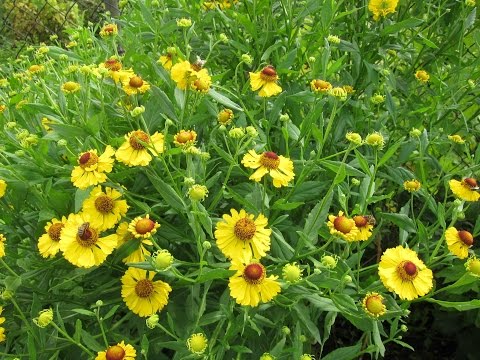

Watch this video on YouTube
After flowering
Seed collection
The seeds must be harvested before the rainy period begins in the fall, otherwise they will simply rot. You can find out about the maturity of the seeds by the tubular flowers that have become black and by the darkened reed flowers. However, it must be remembered that it is recommended to purchase seeds in specialized stores. The same seeds that you have collected have extremely low germination capacity, and they may also not retain the varietal characteristics of the parent plant.
Wintering
For wintering, you need to cut off shoots almost to the surface of the soil, so, only cuttings with a height of 10 to 15 centimeters should rise above the soil. Then the surface of the site is sprinkled with a layer of mulch (sawdust or moss), and lutrasil is distributed over it in order to protect the helenium from a fierce or little snowy winter.


Watch this video on YouTube
Types and varieties of gelenium with photos and names
Despite the fact that this genus is represented by about 32 species, only 5 of them are cultivated. Below is a description of the most popular species.
Helenium bigelovii
This species has received the least distribution in culture. It comes from the West of North America. The height of straight shoots is about 0.8 m. Whole leaf plates are lanceolate. The diameter of the baskets is about 6 centimeters, the middle (tubular) flowers are brown in color, and the reed flowers are yellow. Bloom is observed in June and July.
Spring Helenium (Helenium vernalis)
The height of straight shoots is about 100 centimeters. Solid sheet plates are lanceolate. The diameter of the inflorescences is about 7 centimeters. Tubular flowers are brown, and reed flowers are orange. Flowering lasts about 4 weeks from the second half of May.
Helenium hoopesii
It reaches 0.9 m in height. Solid greenish-gray leaf plates have a lanceolate shape. On long peduncles there are single baskets, which can reach from 8 to 9 centimeters in diameter, they are colored yellow. Flowering is observed in June or July.
Helenium autumnale
This type is the most popular. It is grown by many gardeners, and is also the basis for a large number of varieties. Powerful ligneous shoots can reach a height of 1.6 m, small leaf plates have a serrated edge. The diameter of the baskets is from 3 to 5 centimeters, they are part of the corymbose inflorescences in diameter, which reach 30 centimeters. Reed flowers can be yellow or reddish yellow, tubular flowers are dark yellow. Flowering lasts 8 weeks from July to September.
Helenium hybrid (Helenium x hybridum)
This species is modular, it combines forms of uncertain origin. However, the original species of these plants is autumn helenium.
The most popular are:
- Gelenium Rubintswerg (Ruby Gnome). This variety is the most popular. The height of a dense bush is about 0.65 m. The color of the inflorescences is ruby. The beginning of flowering is observed in the last days of July. This variety can be easily confused with Rosie Jam.
- Cockade... Bushes reach 1.2 m in height. The diameter of the inflorescences-baskets is about 4.5 centimeters. The tubular flowers are brownish-yellow, the ligulate flowers are brownish-red, the edge is yellow, but towards the center they become more red. Flowering lasts 6 weeks and begins in August.
- Moerheim Beauty... This variety is the most popular. The peculiarity of such a plant is that the blossoming flowers have different colors, namely: yellow, copper, red, golden, and after opening they turn brownish-red. The height of the plant depends on the quality of the soil and can vary from 0.9 to 1.2 m. Flowering is observed in July-November.
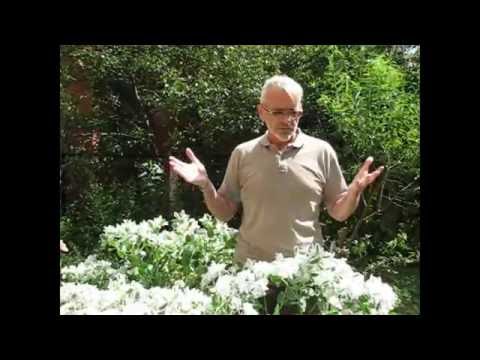

Watch this video on YouTube

